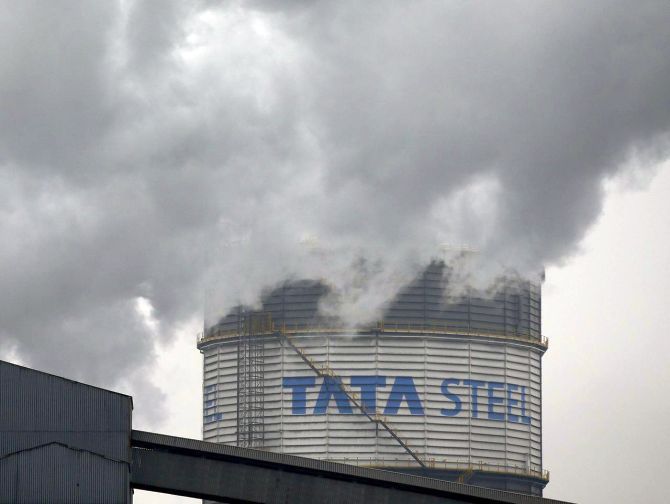 | « Back to article | Print this article |
The steelmaker's India basket grew after Tata Steel completed its acquisition of Bhushan Steel under the Insolvency and Bankruptcy Code process and its subsidiary, Tata Sponge, acquired Usha Martin.

In a year that Tata Steel made two strategically important acquisitions - Bhushan Steel and Usha Martin - it also recorded its highest ever levels of revenues and Ebitda (earnings before interest, taxation, depreciation and amortisation).
N Chandrasekaran, chairman of Tata Steel, said in his annual message to shareholders that on a consolidated basis, the company had achieved the highest ever levels of revenues and Ebitda this year.
Tata Steel has also generated positive free cash flows of Rs 8,839 crore this year, for the first time in over a decade.
The turnover of the group was at Rs 157,669 crore, an increase of 27 per cent over the previous year while the group Ebitda was Rs 29,770 crore, an increase of 39 per cent over the previous year.
Much of it was on account of an increase in deliveries and realisations from domestic operations and increase in realisations at Tata Steel Europe.
The Ebitda increased mainly at Tata Steel on account of improved margins attributable to higher realisaton and acquisition of Bhushan Steel (renamed Tata Steel BSL).
The increase in Ebitda at Tata Steel Europe is attributable to better than expected market conditions with higher selling prices in the European market.
Chandrasekaran said the company’s proposed joint venture with ThyssenKrupp to combine the steel businesses in Europe as a part of a sustainable business had not met with the approval of the European Commission but Tata Steel’s overall situation was much better now.
The Tata Steel management said it would continue to focus on improving the operational performance to enhance the earnings and cash flows to ensure that the European business was self-sustaining.
A significant part of debt carved out of Tata Steel Europe was to be transferred to the proposed joint venture.
However, the Tata Steel management said in the annual report it would continue to focus on deleveraging as a primary strategic initiative to rebuild the balance sheet strength.
During the first half of FY18-19, the gross debt level at Rs 118,680 crore was at its peak owing to the acquisition of Tata Steel BSL.
Through conscious and rigorous efforts, we reduced our gross debt by Rs 17,864 crore to end the year with a debt of Rs 100,816 crore, the management said. However, gross debt at Rs 100,816 crore was higher by Rs 8,699 crore as compared to the previous year.
The increase in borrowings was mainly at Tata Steel BSL and Tata Steel, partly offset by a decrease at Tata Steel Europe and Singapore-based entities.
Net debt was higher by Rs 25,664 crore to Rs 94,879 crore, compared to the previous year in line with increase in gross debt, along with decrease in current investments and cash and bank balances.
The acquisition of Tata Steel BSL appears to have paid off.
The India basket grew after Tata Steel completed its acquisition of Bhushan Steel under the Insolvency and Bankruptcy Code process and its subsidiary, Tata Sponge, acquired Usha Martin in 2018-19.
Tata Steel has also commenced the second phase of Tata Steel Kalinganagar expansion to augment the capacity from three million tonnes to eight million tonnes.
The contribution of Europe to the overall capacity as a consequence of the growth in India has fallen.
The plant in the UK now contributes to 11 per cent of the company’s total capacity and the plant at Ijmuiden in the Netherlands contributes to 22 per cent, said Chanrasekharan in the latest annual report.
The Tata Steel Group recorded total deliveries of 26.80 million tonnes compared to 22.89 million tonnes, largely due to the acquisition of Bhushan Steel (renamed Tata Steel BSL) along with higher volumes from Tata Steel Kalinganagar.
Photograph: Andrew Yates/Reuters